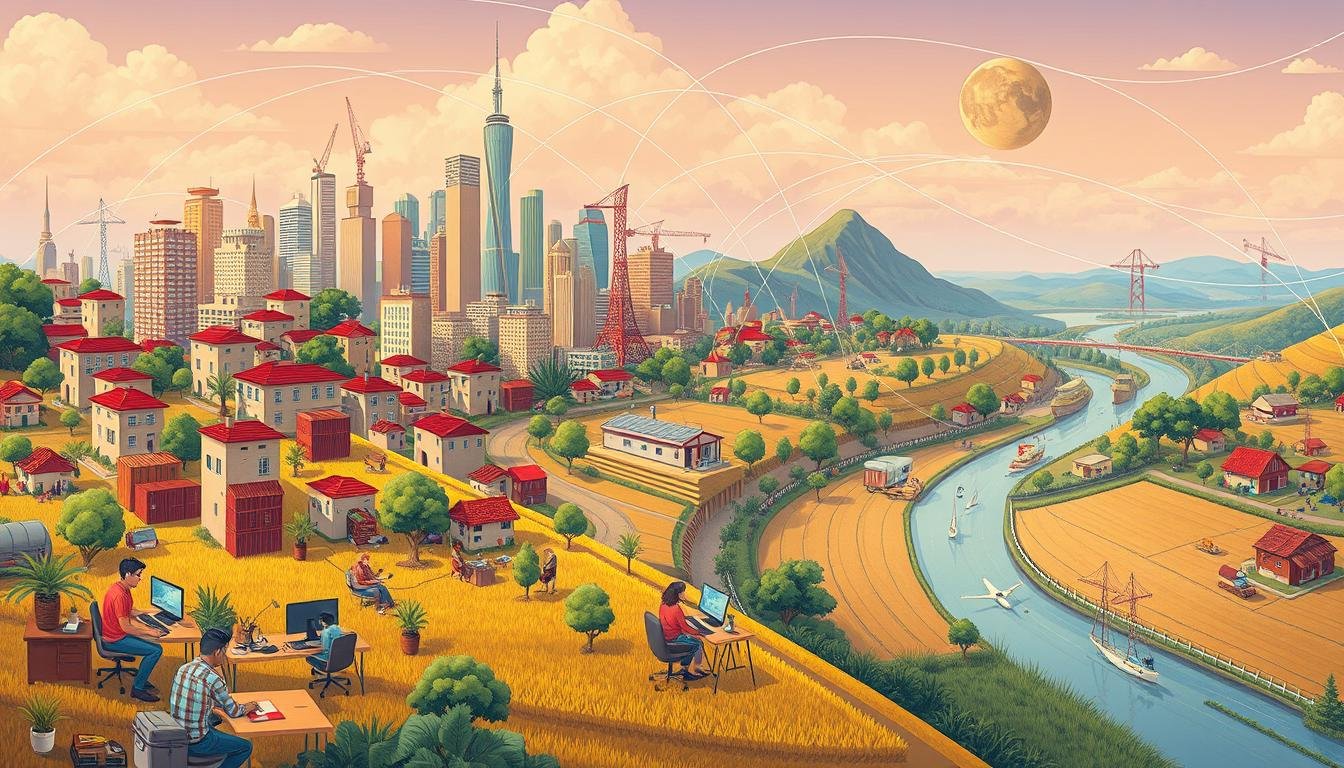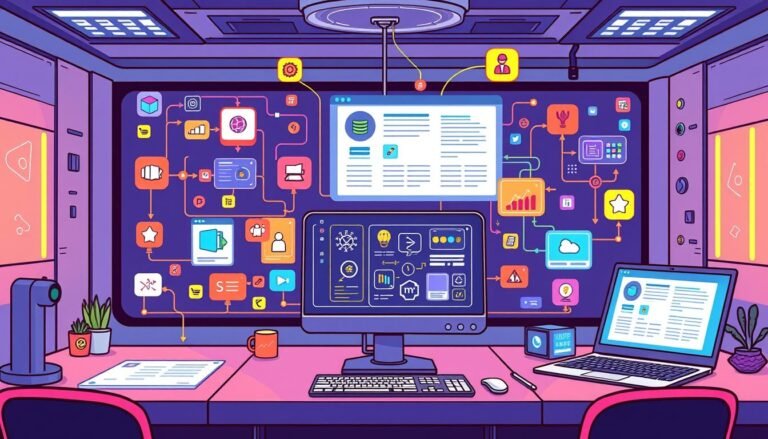The Impact of Globalization and Remote Work on Local Economies
How has the rise of remote work, driven by globalization, reshaped local economies worldwide? We explore how technology and economic changes are changing how businesses work and people make a living.
Globalization has made remote work more common. The internet and digital tools let people work from anywhere. This change challenges old office setups and opens new ways for economic growth.
Key Takeaways
- Remote work trends have surged, driven by advances in technology and the effects of globalization.
- Global companies are leveraging a worldwide talent pool, leading to more diverse and inclusive work environments.
- Workers in developing regions can access better-paying jobs from wealthier countries, impacting local economies positively.
- Flexible, remote employment models help businesses operate around the clock and adapt to global market demands swiftly.
- The expansion of remote work calls for reformation in labor laws, considering cross-border employment complexities.
Introduction to Globalization and Remote Work
In today’s world, globalization and remote work are changing the economy a lot. This globalization introduction aims to explain how these two trends are working together.
The COVID-19 pandemic made remote work more common. Companies with the right tools quickly started working from home. Surveys by PwC and McKinsey show that soon, remote work might be the norm everywhere, leading to big changes in the economy.
Over the last 20 years, technology has made remote work easier. This has helped businesses keep going even when they can’t meet in person. Companies have had to spend a lot on new tech, support for workers, and better pay.
Remote work also lets companies reach more people than before. Forbes says 25 percent of jobs in North America will be remote by 2022. This shows how important it is to know about remote work basics for everyone involved.
The table below shows how big of an impact globalization and remote work have:
| Key Area | Impact |
|---|---|
| Global Expansion | Remote work lets businesses grow worldwide, making more money and being more productive. |
| Urban Migration | Remote work is changing where people live, moving them away from big cities. |
| Office Space Demand | Less need for office space in city centers. |
| Diverse Talent Pool | Companies can find a wide range of talent, helping with diversity and inclusion. |
Looking ahead, companies must work on strong systems for talking and working together. As remote work and globalization keep changing our economy, it’s key to understand how they work together.
Technological Advancements Facilitating Remote Work
Technological advancements have changed the way we work. The internet has made it easier for people to work together from anywhere. This has led to more people working remotely, whether they are digital nomads or part of distributed teams.
The Role of Internet and Communication Tools
Thanks to better internet, businesses can hire talent from all over the world. Fast and reliable internet is key for video calls and teamwork. Tools like Slack, Zoom, and Microsoft Teams help remote workers stay connected, no matter where they are.
But, there are challenges too. In some countries, internet access is poor, making remote work hard. There’s also a gap in digital skills and access to modern devices between rich and poor countries.
Rise of Digital Nomads and Distributed Teams
Thanks to technology, more people can work from anywhere. Digital nomads, for example, work while traveling. They enjoy a better work-life balance and get to see new places.
Distributed teams, on the other hand, work from different places. This lets companies find the best talent, no matter where they are. Services help these teams work well together, combining skills from all over.
| Aspect | Developed Nations | Developing Nations |
|---|---|---|
| Internet Connectivity | Reliable, High-speed | Inconsistent, Limited Access |
| Mobile Devices | Advanced, Modern | Outdated Technologies |
| Digital Literacy | High | Variable |
| Remote Work Resources | Ample (Coworking Spaces, Equipment) | Limited |
| Cybersecurity | Strong Laws and Policies | Less Comprehensive |
The growth of digital nomads and distributed teams shows the power of technology. As more companies adopt remote work, we’ll see efforts to close the gaps and create a more inclusive global workforce.
Restructuring Economic Models Through Remote Work
The COVID-19 pandemic changed how we work, making remote work more common. This change has led to economic restructuring and new ways of working. Now, remote work is seen as essential, showing a lasting change in how we work worldwide. New tech, like Zoom and Microsoft Teams, has made working from home easier.
Shifting Dynamics in Urbanization and Workforce Migration
Remote work is changing where people live and work. It’s no longer needed to live in cities to find jobs. This means cities and rural areas are more balanced.
Companies with remote work can find talent from all over. This helps solve talent shortages and makes workplaces more diverse.
Impact on Cost of Living Disparities and Local Economies
Remote work can make living costs more even between cities and countryside. It helps local economies grow stronger. It also makes work-life balance better, reducing stress and improving happiness.
This change is key for making cities better places to live. It helps cities be more sustainable and livable.
| Aspect | Impact |
|---|---|
| Urbanization Shifts | Reduced congestion in urban centers, demographic balance |
| Workforce Migration | Access to a global talent pool, enhanced diversity |
| Cost of Living Disparities | Decreased disparities between urban and rural areas |
| Economic Restructuring | More sustainable local economies |
Employment Opportunities and Workforce Diversification
Globalization and remote work have opened up employment opportunities worldwide. This means companies can find talent from anywhere, not just locally. This leads to more diverse teams and new ideas.
The International Labor Organization says global unemployment is going down. But, in places like Russia, China, and Mexico, workers are earning more. This shows how different countries are affected by global changes.
In the US, healthcare is facing a big talent shortage. This has led to higher pay for these jobs. It shows how important it is to have a diverse workforce to meet these needs. Also, workers need to keep learning to stay ahead in the global job market.
Companies are investing in training their workers. This is because using what they already have is key. New tools for finding talent have made hiring faster and cheaper, helping companies find the right people from all over.
Now, skills like communication and teamwork are more important than ever. This is because machines are doing more tasks. Companies are focusing on these skills to work well with people from different cultures.
The table below shows important facts about jobs and diversity:
| Country/Region | Unemployment Trends | Income Changes | Sector Highlights |
|---|---|---|---|
| Russian Federation, China, Mexico | Declining | Increasing | Diverse sector growth |
| United States | Declining | Stagnant | Healthcare talent shortages |
| APAC Region | Declining | Stagnant | Flexibility demands |
The gig economy has its downsides, like not knowing when you’ll get paid. But, more legal jobs and better pay are making it better. Also, having teams from different cultures is making work more creative and fun.
More people are working from home, which is good for them and for companies. It saves money and helps people balance work and life better. Tools like video calls and project software help teams work together, even if they’re far apart.
Training programs are teaching workers about different cultures. This helps them succeed in a global world. Companies are also changing how they pay and what benefits they offer to fit local laws and keep up with the competition.
In short, the mix of global work and remote jobs is changing how we work. By focusing on diversity and skills, companies can grow and innovate with a global team.
The Impact of Globalization and Remote Work on Local Economies
Globalization and remote work have changed local economies a lot. They bring both chances and tough issues like labor laws and economic growth.
Challenges in Labor Laws and Cross-Border Employment
Remote work has made labor laws challenges grow, especially for jobs across borders. A study found 68% of companies face legal hurdles with remote work worldwide. This shows we need new rules for remote workers’ rights, taxes, and benefits.
- Labor laws need to adapt to ensure fair treatment of remote workers.
- Tax policies must address income generated across borders.
- Companies need clear guidelines for international hiring and compliance.
By solving these labor laws challenges, businesses can build a more diverse and inclusive team. This helps them grow stronger.
Sustainable Development Goals and Local Economic Growth
Remote work can help meet sustainable development goals and boost local economic growth. For example, it cuts down on emissions from commuting by millions of tons each year. This not only lowers carbon emissions but also helps local economies grow.
- Remote work reduces the need for daily commutes, lowering emissions.
- Decentralized work supports growth in previously marginalized communities.
- Encouraging remote work fosters economic inclusivity and sustainability.
Also, hiring globally brings in diverse talent, with 33% of diverse teams doing better. This helps businesses grow and innovate, helping local economies thrive.
| Indicator | Value |
|---|---|
| Annual Economic Growth | 3.2% (2024-2025) |
| Spending on Digital Transformation | $2.5 trillion (2024) |
| International Remote Workers Increase | 15% (last decade) |
Global Initiatives Supporting Remote Work
In recent years, the world has seen a rise in support for remote work. Broadband technology and government support have been key. They help grow the economy and reach more people in areas that were once left behind.
Broadband Rollout and Government Policies
Across the globe, countries have seen the value of fast internet for remote work. They’ve expanded broadband to rural and remote areas. This move lets more people join the digital economy, no matter where they live.
Studies show that when workers are far apart, communication changes. Harvard Business School’s Prithwiraj Choudhury found a drop in phone and video calls. Instead, tasks now rely more on emails and messages. This shift supports flexible work hours, thanks to better internet.
Government policies, like tax breaks and grants, are also key. For example, countries with shorter workweeks have less off-hours work. This shows the importance of considering work schedules for teams around the world.
Case Studies: Tulsa, Oklahoma, and Ireland’s Rural Future Plan
Tulsa, Oklahoma, and Ireland’s Rural Future Plan are great examples. Tulsa Remote offers grants and relocation help, attracting professionals. This has boosted Tulsa’s economy and made the city more vibrant.
Ireland’s plan focuses on broadband and incentives for rural living. It aims to reduce city crowding and boost local economies. As a result, Ireland’s rural areas are seeing new life, thanks to remote workers.
| Country | Initiative | Impact |
|---|---|---|
| USA | Tulsa Remote | Increased economic activity and urban development |
| Ireland | Rural Future Plan | Economic revitalization of rural communities |
Future Trends and Predictions
Looking ahead, we see big changes in remote work, thanks to globalization trends and economic predictions. The global outsourcing industry is growing fast. It now includes jobs like customer service and technical roles, not just manufacturing.
The COVID-19 pandemic made remote work popular worldwide. New tech in communication and collaboration makes it easier. This digital shift will keep changing how and where we work.
Remote work has many benefits. It gives employees more flexibility and access to more talent. But, it also has challenges like feeling isolated and balancing work and life. The rise of digital outsourcing lets small businesses hire freelancers from anywhere.
- More than 20% of the global workforce could work remotely three to five days a week. This could triple the number of remote workers after the pandemic.
- But, over 50% of the workforce can’t work from home. They need to be there for tasks like using special machinery or direct interaction, like in healthcare or manufacturing.
Companies are now thinking differently about their global presence. They’re looking to diversify their supply chains and rethink where they make products. The U.S. public is worried about how international trade affects jobs and supply chains.
Economic forecasts show that housing affordability is a big concern. Countries are trying new solutions like selling air rights and master-planned developments to improve housing policies.
| Sector | Potential for Remote Work | Comments |
|---|---|---|
| Finance and Insurance | 75% | High potential due to the nature of activities being easily digitized. |
| Business Services | 60% | Majority of activities can be performed remotely without productivity loss. |
| Healthcare | 11% | Limited remote work potential except for consultation and administrative roles. |
| Emerging Economies | 12% | Physical and manual activities predominant, requiring on-site presence. |
The future of remote work and the global economy are closely linked. Globalization trends and economic predictions show a complex picture. As these trends evolve, they will change how we work and see the world.
Conclusion
As we wrap up, it’s clear that globalization and remote work are changing local and global economies. New technologies have led to big changes, starting with the Industrial Revolution and moving to today’s digital world. Things like steamships, railways, air travel, and the internet have made it easier to trade goods and services.
The World Trade Organization (WTO) and open trade policies have also helped economies grow together. This has made it easier for countries to work together and share resources.
Globalization and remote work have a big effect on how much people earn. People in richer areas tend to earn more when working remotely. The way wages change with GDP and exchange rates shows how global economics affect local pay.
Remote workers see about 80% of exchange rate changes in their local wages. This shows how connected the world’s economy is.
Looking ahead, we’re hopeful but also careful. Globalization has brought many benefits like better productivity and easier trade. But, it also brings challenges like income gaps and environmental issues.
By looking at more than just GDP, we get a full picture of how societies are doing. This helps us understand the good and bad of our changing world. As we move forward, we must find ways to handle the ups and downs of a globalized world with remote work.
Source Links
- The Impact of Globalization on Remote Work
- Remote Work and the New Era of Globalisation | Bettersource
- The Impact of Globalization on Local Economies: A Detailed Analysis of Its Effects and Implications
- How is Remote Work Changing the Global Economy
- How is Remote Work Boosting Regional Economies? | G-P
- The Impact of Remote Work on Urban Economies: A Post-Pandemic Analysis
- The relationship between globalisation and the rise of remote work
- Remote working and digital transformation during the COVID-19 pandemic: Economic–financial impacts and psychological drivers for employees
- How remote work culture differs between developed vs developing nations and how it can create opportunities for developing nations
- How Remote Work Is Shaping Company Cultures Globally | Ryptic
- The Impact of Globalization on the Job Market: New Opportunities and Challenges for Professionals – Mid Hudson News
- The Impact of Globalization on the Workplace – 1Ansah Technologies
- Remote Work Breaks Down Barriers for the Everywhere Workforce
- Types of Globalization: How They Influence Remote Work and International Collaboration
- Global Talent, Local Obstacles: Why Time Zones Matter in Remote Work | Working Knowledge
- The global polarisation of remote work
- The Future of Work is Remote: How Outsourcing is Reshaping Employment
- The Trends That Will Define the Global Economy in 2024 – ProMarket
- What’s next for remote work: An analysis of 2,000 tasks, 800 jobs, and nine countries
- Globalization’s Impact on Economic Development: Unveiling the Effects








